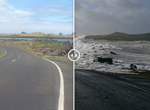Extreme Weather Events
Climate change is influencing all extreme weather events in Australia.
The changing nature of our climate and rise in extreme weather events is acknowledged both nationally and internationally as a growing risk. Extreme weather events like storms, heatwaves, floods and cyclones are predicted to become even more intense and destructive over the coming decades because of past and present greenhouse emissions.
No single extreme weather event can be attributed to climate change. However global warming amplifies the risk factors for extreme weather events. Research points to an emerging pattern of more frequent and more intense extreme weather conditions, and scientists predict that this will continue as a result of rising concentrations or greenhouse gases in the atmosphere.
Scientists have observed increases in global land and ocean temperatures, ocean heat content, rising sea levels and the retreat of glaciers and ice sheets, all of which indicate a global warming.
Extreme weather events occur as part of the natural variability of regional and global climates. Scientists understand, through satellite observations of tropical rainfall events, that there is a clear link between temperature and rainfall extremes.
Extreme weather events linked to global warming and climate change are likely to have the greatest potential impact on natural systems, including humans.
All extreme weather events are now occurring in an atmosphere that is warmer and wetter than it was in the 1950s. Across Australia, extreme weather events are projected to worsen as the climate warms further.
- Heatwaves are becoming hotter, lasting longer and occurring more often. Extreme heat is projected to increase across the entire continent, with significant increases in the length, intensity and frequency of heatwaves in many regions.
- Extreme fire weather and the length of the fire season is increasing, leading to an increase in bushfire risk.
- Sea level has already risen and continues to rise, driving more devastating coastal flooding during storm surges. The intensity of extreme rainfall events is also projected to increase across most of Australia. The increase in coastal flooding from high sea level events will become more frequent and more severe as sea levels continue to rise.
- The time spent in drought is projected to increase across Australia, especially in southern Australia. Extreme drought is expected to increase in both frequency and duration.
In recent years the Barwon South West Region has experienced a number of extreme weather events, ranging from flooding and storms through to extreme heat, often resulting in bushfires.
For example, the Southern Grampians experienced extensive bushfires in early 2013 and flooding in 2016 as well as bushfires across the Region in 2011. There have been storm surges and subsequent flooding along parts of the Great Ocean Road such as in 2009. Flooding due to extreme rainfall events has occurred in numerous locations across the region in 2010 and 2011 and more recently in 2016. In addition the Region has experienced heatwaves since 2009 often experiencing record breaking temperatures.
The variety, frequency and geographical spread of these events, combined with projected future climatic conditions, highlight the urgency for the Region to build resilience and adaptive capacity into the future. There is broad recognition between councils, service providers and industry in this Region of the importance of building the resilience of communities, the environment and industry to better cope with a harsher future.
Extreme Weather Events
The below links provide information and interactive photographs highlighting specific extreme weather events that have occurred in the Barwon South West in recent years.
Barongarook Creek Flood Event
Wye River & Separation Creek Fires
Moyne Coastal Inundation
Queenscliff Coastal Inundation









